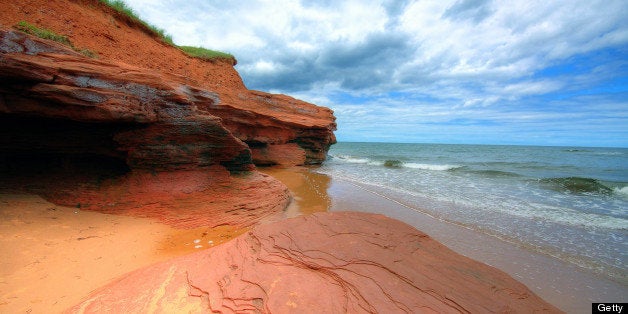
Tomorrow I'm headed to Prince Edward Island for a long weekend. This is no easy feat. From my house in Massachusetts, it takes a full eleven hours to drive to PEI in the Canadian Maritimes, where my family owns a farmhouse built in 1900 that looks pretty much the same as it always has. It will be tough to go up for just a few days instead of several sun-drenched summer weeks, but this time my trip is all about researching a setting for a book.
Our house has the peaked roof and simple lines of most of the Victorian era farmhouses on Prince Edward Island, and it's surrounded by potato fields that flower white in the summer. The road is edged with bright lupine in spring, in astonishing Disney purples and pinks. In the fall the fields are tinged in red and gold and the flowers are scarlet and orange.
The beach is just a mile away, down a red clay road like so many other red clay roads on PEI that lead to secret coves. The beaches on the south side of the eastern tip of the island are soft and white, while the beaches on the northern side are red. There are red cliffs on both sides, dropping in dramatic folds to the Northumberland Straight on the southern shore -- across which you can see Cape Breton Island on a clear day -- and the Gulf of Saint Lawrence on the north. At the tip of the island, just a few miles from my house, the Gulf meets the Strait near a lighthouse with a decent cafe, and no morning is better than the ones that start with eggs and bacon and strong Northside tea as you watch the surf crash below those cliffs, with occasional seals bobbing about with the cormorants diving for fish.
This part of Prince Edward Island is far from the "crowds" -- which, believe me, are nothing like you see on Cape Cod or even around Maine's coastal towns in summer -- who gather to worship at the shrine of Lucy Maud Montgomery, creator of Anne of Green Gables. That red-haired orphan is the subject of the longest-running musical on the island, and draws Japanese tourists by the busload, for some mysterious reason, mostly women, most of them donning hats with red braids attached to have their photos taken.
My house on PEI is an hour away from Charlottetown, too, the birthplace of Canada's Confederation, a charming town of brick and cobblestones that boasts an astonishing array of restaurants, musical venues, and art galleries. But we see none of that where I go to write.
No, where we are, there are the potato fields in front of the house and to one side. Behind the house is another farm with sheep grazing in the fields. How could I help but make one of the characters in my next book, Haven Lake (April 2015) be a shepherdess, after all of those hours of sitting on my deck and watching the sheep do their thing?
And now, after over twenty years of spending vacations on the island, I am writing a book that is set partly there, and partly in Massachusetts. I'm excited but terrified.
To me, settings are far more than just places in books. I view settings as essential components of every novel, because so often places convey the interior landscapes of the characters and deepen the reader's experience. In my first novel, THE WISHING HILL, I set some of the action overlooking an old snuff mill where one of the characters worked long ago. The antique building's Gothic lines, rusty water wheels and stained clapboards seemed like the perfect metaphor for an unrequited love. And in my second novel, Beach Plum Island, I used Plum Island as the setting because a barrier island--battered as it is by wind and rain, snow and tides--changes shape constantly, just as our lives change shape according to the external forces we experience as parents and lovers, mourners and creatures who inhabit the earth only temporarily.
Now that I'm looking at Prince Edward Island not just as a sanctuary, but as a setting for my next novel, Chance Harbor, this trip will take on a whole new meaning for me. I'll be trying to view the island through the eyes of my characters--the colors and cliffs, the lobster fishing and Northeasters, the lighthouses and vast empty beaches will all have meaning, depending on the turmoil I decide to put my characters through. The eastern tip of this island, which really does feel like the end of the world, is the perfect setting for these characters, who are all reinventing themselves in some way, having to let go of their old lives and forgive the people who betrayed them as they move forward.
Should be fun, but daunting. I want to do this island justice, because this magical place is as much a part of my own inner landscape as it will be for my characters.
